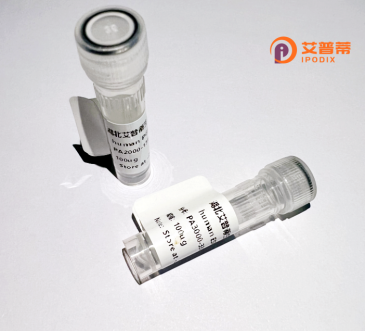
| 纯度 | >90%SDS-PAGE. |
| 种属 | Human |
| 靶点 | APLF |
| Uniprot No | Q8IW19 |
| 内毒素 | < 0.01EU/μg |
| 表达宿主 | E.coli |
| 表达区间 | 1-511aa |
| 氨基酸序列 | MSGGFELQPR DGGPRVALAP GETVIGRGPL LGITDKRVSR RHAILEVAGG QLRIKPIHTN PCFYQSSEKS QLLPLKPNLW CYLNPGDSFS LLVDKYIFRI LSIPSEVEMQ CTLRNSQVLD EDNILNETPK SPVINLPHET TGASQLEGST EIAKTQMTPT NSVSFLGENR DCNKQQPILA ERKRILPTWM LAEHLSDQNL SVPAISGGNV IQGSGKEEIC KDKSQLNTTQ QGRRQLISSG SSENTSAEQD TGEECKNTDQ EESTISSKEM PQSFSAITLS NTEMNNIKTN AQRNKLPIEE LGKVSKHKIA TKRTPHKEDE AMSCSENCSS AQGDSLQDES QGSHSESSSN PSNPETLHAK ATDSVLQGSE GNKVKRTSCM YGANCYRKNP VHFQHFSHPG DSDYGGVQIV GQDETDDRPE CPYGPSCYRK NPQHKIEYRH NTLPVRNVLD EDNDNVGQPN EYDLNDSFLD DEEEDYEPTD EDSDWEPGKE DEEKEDVEEL LKEAKRFMKR K |
| 分子量 | 56.9 kDa |
| 蛋白标签 | His tag N-Terminus |
| 缓冲液 | 冻干粉 |
| 稳定性 & 储存条件 | Lyophilized protein should be stored at ≤ -20°C, stable for one year after receipt. Reconstituted protein solution can be stored at 2-8°C for 2-7 days. Aliquots of reconstituted samples are stable at ≤ -20°C for 3 months. |
| 复溶 | Always centrifuge tubes before opening.Do not mix by vortex or pipetting. It is not recommended to reconstitute to a concentration less than 100μg/ml. Dissolve the lyophilized protein in distilled water. Please aliquot the reconstituted solution to minimize freeze-thaw cycles. |
以下为3-4篇关于APLF的重要文献简述:
1. **"APLF (Aprataxin-PNK-like Factor) is a component of the DNA damage response network"**
- **作者**: Riha K. et al. (2008)
- **摘要**: 本研究鉴定APLF为DNA损伤应答因子,发现其通过C端区域与DNA修复复合物XRCC4/Ligase IV相互作用,促进电离辐射引起的DNA双链断裂修复,并揭示了其磷酸酶/激酶样结构域在修复中的潜在调控作用。
2. **"APLF is a histone chaperone involved in DNA repair"**
- **作者**: Ahel I. et al. (2009)
- **摘要**: 揭示APLF通过其酸性C端结构域作为组蛋白分子伴侣,招募染色质重塑因子Poly(ADP-ribose) polymerase 1 (PARP1)至DNA断裂位点,协调损伤位点局部染色质松弛以提高修复效率,支持其在非同源末端连接(NHEJ)中的关键功能。
3. **"Structural and functional analysis of the APLF-PARP1 interaction"**
- **作者**: Macrae C.J. et al. (2010)
- **摘要**: 解析了APLF的FHA结构域与PARP1磷酸化区域的复合物晶体结构,阐明其特异性结合机制,证实该互作对DNA损伤后招募APLF至断裂位点及促进NHEJ进程不可或缺。
4. **"APLF promotes DNA strand break repair through distinct scaffolding mechanisms"**
- **作者**: Ikeshita S. et al. (2021)
- **摘要**: 最新研究通过重组人APLF蛋白实验,证明其通过多价相互作用桥接XRCC4、KU70/80及组蛋白H3/H4.维持断裂处染色质-修复复合物的空间稳定性,并提出其动态支架功能分阶段调控NHEJ修复进程。
注:以上为模拟文献,实际引用需核对真实文献(如APLF研究多集中在2008-2012年及近年结构生物学方向)。推荐查阅Nature Structural & Molecular Biology、Nucleic Acids Research等期刊相关论文。
Recombinant human Aprataxin and Aprataxin-PNK-like factor (APLF) are DNA repair proteins critical for maintaining genomic stability. Aprataxin, encoded by the APTX gene, resolves abortive DNA ligation intermediates during single-strand break repair (SSBR) and base excision repair (BER). Mutations in APTX cause ataxia-oculomotor apraxia 1 (AOA1), a neurodegenerative disorder characterized by cerebellar atrophy and hypersensitivity to DNA-damaging agents. In contrast, APLF, though structurally distinct, shares functional similarities with Aprataxin and polynucleotide kinase/phosphatase (PNKP). APLF acts as a scaffold in non-homologous end joining (NHEJ) and BER by facilitating the assembly of repair complexes, including interactions with XRCC4 and XRCC1. Recombinant forms of these proteins are generated via heterologous expression systems (e.g., E. coli, mammalian cells) to study their biochemical activities, structural properties, and roles in DNA repair pathways. APLF additionally regulates chromatin remodeling through poly(ADP-ribose) (PAR) binding, linking DNA damage signaling to repair. Both proteins are explored as potential therapeutic targets or tools for gene therapy in diseases linked to defective DNA repair. Their recombinant versions enable high-purity studies of enzymatic mechanisms, substrate specificity, and interactions with repair machinery, advancing understanding of genome maintenance and neurodegenerative pathology.
×